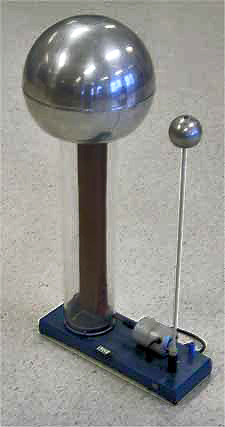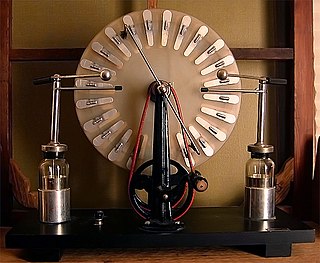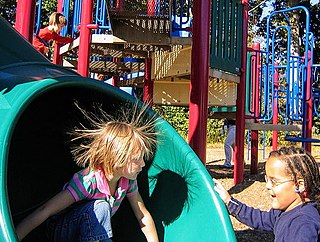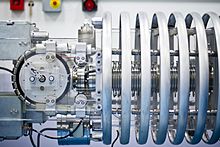
A Van de Graaff generator is an electrostatic generator which uses a moving belt to accumulate electric charge on a hollow metal globe on the top of an insulated column, creating very high electric potentials. It produces very high voltage direct current (DC) electricity at low current levels. It was invented by American physicist Robert J. Van de Graaff in 1929. The potential difference achieved by modern Van de Graaff generators can be as much as 5 megavolts. A tabletop version can produce on the order of 100 kV and can store enough energy to produce visible electric sparks. Small Van de Graaff machines are produced for entertainment, and for physics education to teach electrostatics; larger ones are displayed in some science museums.

Capacitance is the capability of a material object or device to store electric charge. It is measured by the charge in response to a difference in electric potential, expressed as the ratio of those quantities. Commonly recognized are two closely related notions of capacitance: self capacitance and mutual capacitance. An object that can be electrically charged exhibits self capacitance, for which the electric potential is measured between the object and ground. Mutual capacitance is measured between two components, and is particularly important in the operation of the capacitor, an elementary linear electronic component designed to add capacitance to an electric circuit.

Robert Jemison Van de Graaff was an American physicist, noted for his design and construction of high-voltage Van de Graaff generators. He spent most of his career in the Massachusetts Institute of Technology (MIT).

The Wimshurst machine or Wimshurst influence machine is an electrostatic generator, a machine for generating high voltages developed between 1880 and 1883 by British inventor James Wimshurst (1832–1903).

Static electricity is an imbalance of electric charges within or on the surface of a material. The charge remains until it can move away by an electric current or electrical discharge. The word "static" is used to differentiate it from current electricity, where an electric charge flows through an electrical conductor.

In electromagnetism, an electrophorus or electrophore is a simple, manual, capacitive, electrostatic generator used to produce charge via the process of electrostatic induction. A first version of it was invented in 1762 by Swedish professor Johan Carl Wilcke. Italian scientist Alessandro Volta improved and popularized the device in 1775, and is sometimes erroneously credited with its invention. The word electrophorus was coined by Volta from the Greek ήλεκτρον, elektron, and φορεύς, phoreus, meaning 'electricity bearer'.

A linear particle accelerator is a type of particle accelerator that accelerates charged subatomic particles or ions to a high speed by subjecting them to a series of oscillating electric potentials along a linear beamline. The principles for such machines were proposed by Gustav Ising in 1924, while the first machine that worked was constructed by Rolf Widerøe in 1928 at the RWTH Aachen University. Linacs have many applications: they generate X-rays and high energy electrons for medicinal purposes in radiation therapy, serve as particle injectors for higher-energy accelerators, and are used directly to achieve the highest kinetic energy for light particles for particle physics.

A corona discharge is an electrical discharge caused by the ionization of a fluid such as air surrounding a conductor carrying a high voltage. It represents a local region where the air has undergone electrical breakdown and become conductive, allowing charge to continuously leak off the conductor into the air. A corona discharge occurs at locations where the strength of the electric field around a conductor exceeds the dielectric strength of the air. It is often seen as a bluish glow in the air adjacent to pointed metal conductors carrying high voltages, and emits light by the same mechanism as a gas discharge lamp. Corona discharges can also happen in weather, such as thunderstorms, where objects like ship masts or airplane wings have a charge significantly different from the air around them.

Electrostatic induction, also known as "electrostatic influence" or simply "influence" in Europe and Latin America, is a redistribution of electric charge in an object that is caused by the influence of nearby charges. In the presence of a charged body, an insulated conductor develops a positive charge on one end and a negative charge on the other end. Induction was discovered by British scientist John Canton in 1753 and Swedish professor Johan Carl Wilcke in 1762. Electrostatic generators, such as the Wimshurst machine, the Van de Graaff generator and the electrophorus, use this principle. See also Stephen Gray in this context. Due to induction, the electrostatic potential (voltage) is constant at any point throughout a conductor. Electrostatic induction is also responsible for the attraction of light nonconductive objects, such as balloons, paper or styrofoam scraps, to static electric charges. Electrostatic induction laws apply in dynamic situations as far as the quasistatic approximation is valid.

High voltage electricity refers to electrical potential large enough to cause injury or damage. In certain industries, high voltage refers to voltage above a certain threshold. Equipment and conductors that carry high voltage warrant special safety requirements and procedures.

An electrostatic generator, or electrostatic machine, is an electrical generator that produces static electricity, or electricity at high voltage and low continuous current. The knowledge of static electricity dates back to the earliest civilizations, but for millennia it remained merely an interesting and mystifying phenomenon, without a theory to explain its behavior and often confused with magnetism. By the end of the 17th century, researchers had developed practical means of generating electricity by friction, but the development of electrostatic machines did not begin in earnest until the 18th century, when they became fundamental instruments in the studies about the new science of electricity.

The Cockcroft–Walton (CW) generator, or multiplier, is an electric circuit that generates a high DC voltage from a low-voltage AC or pulsing DC input. It was named after the British and Irish physicists John Douglas Cockcroft and Ernest Thomas Sinton Walton, who in 1932 used this circuit design to power their particle accelerator, performing the first artificial nuclear disintegration in history. They used this voltage multiplier cascade for most of their research, which in 1951 won them the Nobel Prize in Physics for "Transmutation of atomic nuclei by artificially accelerated atomic particles".

The Kelvin water dropper, invented by Scottish scientist William Thomson in 1867, is a type of electrostatic generator. Kelvin referred to the device as his water-dropping condenser. The apparatus is variously called the Kelvin hydroelectric generator, the Kelvin electrostatic generator, or Lord Kelvin's thunderstorm. The device uses falling water to generate voltage differences by electrostatic induction occurring between interconnected, oppositely charged systems. This eventually leads to an electric arc discharging in the form of a spark. It is used in physics education to demonstrate the principles of electrostatics.

The Denys Wilkinson Building is a prominent 1960s building in Oxford, England, designed by Philip Dowson at Arup in 1967.

A particle accelerator is a machine that uses electromagnetic fields to propel charged particles to very high speeds and energies, and to contain them in well-defined beams.

A corona ring, more correctly referred to as an anti-corona ring, is a toroid of conductive material, usually metal, which is attached to a terminal or other irregular hardware piece of high voltage equipment. The purpose of the corona ring is to distribute the electric field gradient and lower its maximum values below the corona threshold, preventing corona discharge. Corona rings are used on very high voltage power transmission insulators and switchgear, and on scientific research apparatus that generates high voltages. A very similar related device, the grading ring, is used around insulators.

An electrostatic particle accelerator is a particle accelerator in which charged particles are accelerated to a high energy by a static high voltage potential. This contrasts with the other major category of particle accelerator, oscillating field particle accelerators, in which the particles are accelerated by oscillating electric fields.

The Westinghouse Atom Smasher was a 5 million volt Van de Graaff electrostatic nuclear accelerator operated by the Westinghouse Electric Corporation at their Research Laboratories in Forest Hills, Pennsylvania. It was instrumental in the development in practical applications of nuclear science for energy production. In particular, it was used in 1940 to discover the photofission of uranium and thorium, and was most cited for certain nuclear physics measurements. The Westinghouse Atom Smasher was able to make precise measurements of nuclear reactions for research in nuclear power. It was the first industrial Van de Graaff generator in the world, and marked the beginning of nuclear research for civilian applications. Built in 1937, it was a 65-foot-tall (20 m) pear-shaped tower. It went dormant in 1958. In 1985, it was named an Electrical Engineering Milestone by the Institute of Electrical and Electronics Engineers.
This article provides information on the following six methods of producing electric power.
- Friction: Energy produced by rubbing two material together.
- Heat: Energy produced by heating the junction where two unlike metals are joined.
- Light: Energy produced by light being absorbed by photoelectric cells, or solar power.
- Chemical: Energy produced by chemical reaction in a voltaic cell, such as an electric battery.
- Pressure: Energy produced by compressing or decompressing specific crystals.
- Magnetism: Energy produced in a conductor that cuts or is cut by magnetic lines of force.
















